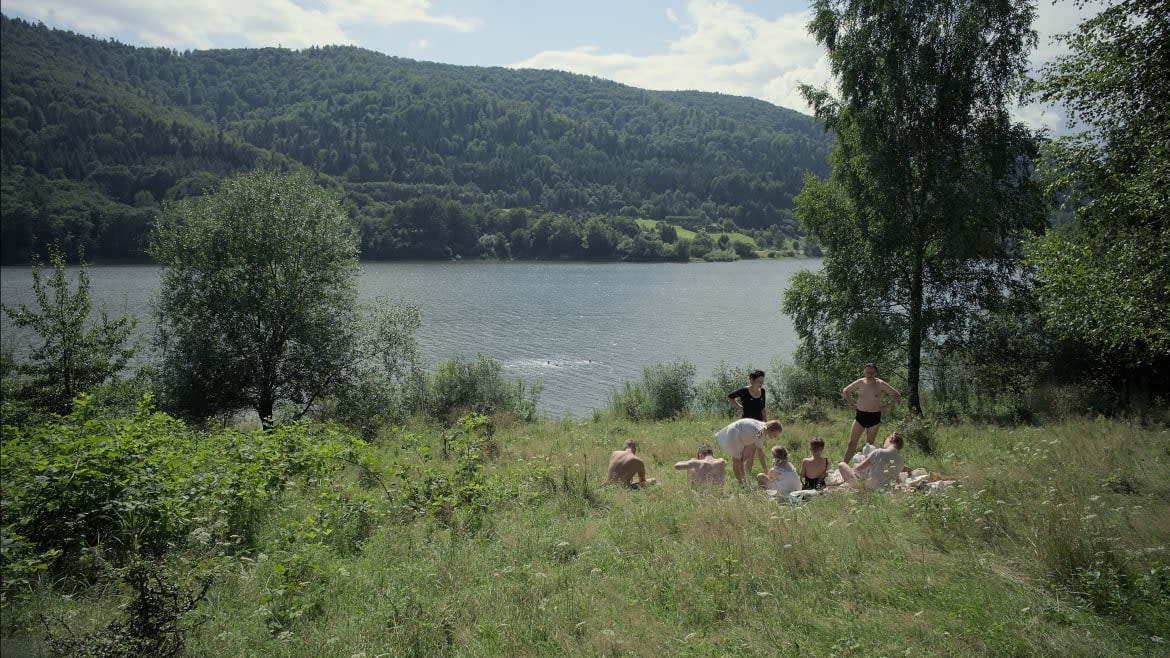A New Holocaust Film Masterpiece Just Debuted at Cannes

- Oops!Something went wrong.Please try again later.
Attending a gala screening at the Cannes Film Festival is a strange experience. No matter what movie is playing, men are in tuxes and women are in formalwear. Pop music and oldies blast on the red carpet. Cameras snap celebrities in Chopard jewels and occasionally random attendees who have put on something absurd to catch photographers’ attention.
I walked into the Grand Lumière on Friday night in awe of the bizarre pomp but also eager and a little nervous for what I was about to see: Jonathan Glazer’s The Zone of Interest. All I knew about the Under the Skin director’s first film in nearly a decade was that it was about Nazis living just outside Auschwitz and that it was based on a Martin Amis novel but was apparently vastly different from its source material. I also was aware that Glazer, known for films like Birth and Sexy Beast, makes strange and exciting work that defies expectations.
And sure enough, you could feel an uneasy chill descend on the enormous theater full of people who had just gawked at the likes of Cate Blanchett and Natalie Portman, when Glazer’s film began with an extended sequence of a black screen as Mica Levi’s disorienting score blared. At one point, there was a smattering of applause as the blackness continued, as if that corner of the audience thought there was something wrong and wanted to urge the movie to actually start. But it had already.
The Zone of Interest is being hailed as the first great movie to emerge from this year’s Cannes and for good reason. It’s a disturbing and brilliant film that challenges what it means to make a Holocaust movie.
When the screen finally alights following that period of extended darkness, it features a picturesque image of a family by a lake. They are shot from a distance, composed almost like Seurat’s bathers, but this is not France. It is Poland, near Auschwitz, and the people we are watching are Rudolf and Hedwig Höss, the concentration camp’s commandant and his wife, played by Christian Friedel and Sandra Hüller.
The structure of the film will indeed baffle some viewers as it likely did those around me who walked out early into the runtime. Glazer, who shot on location, simply observes the Höss brood as they go about their days in their house. Hedwig tries on a fur coat she has taken from a Jewish woman, giving it to her housekeeper to mend. She later gossips with her friends about the other items they have stolen.
Rudolf hears a pitch for a new design of crematorium. They garden, have parties, ride horses, and generally enjoy their lives all the while there are wails of pain just on the other side of the cement wall that separates them from the terror they inflict. Every so often smoke fills the sky. You can’t help but think of the smell these people must be ignoring as they try to surround themselves with beauty. Their evil registers not in the way it is typically shown on screen—through brazen violence—but in the casualness with which they go about their days. Their compartmentalization is horrific. Suffering is just their daily soundtrack, nothing to concern them.
Glazer, a Jewish filmmaker, is not exactly humanizing the Hösses, but nor is he editorializing. He explained during a press conference the next day he didn’t want to show them as monsters. “The great crime and tragedy is that human beings did this to other human beings and it’s very convenient for us to try and distance ourselves from them as much as we can because obviously we think we can never behave this way and we don’t behave this way,” Glazer said. “But I think we should be less certain in that.”
Most of the action takes place in the Höss home, which Glazer captured remotely: There were 10 cameras on set that captured scenes playing out at the same time in different rooms. He kept his distance, watching from a trailer. However, Glazer occasionally breaks away from the ostensible protagonists, allowing Levi’s unnerving sounds to take hold as the image reverses into night vision negative, and we see a young girl from the Polish resistance picking up fallen apples and leaving them for the prisoners.
Her story is presented in distorted form, but adds an element of grace that is almost hard to articulate after just seeing it one time. The kindness is otherworldly; the horror is routine.
I kept thinking about the way the movie depicts the remarkable ability to ignore what is easy to witness after it ended, during an extended standing ovation. I was shaken, taking deep breaths to register Glazer’s work. And then I noticed a woman in a sparkly red gown. She seemed unfazed. She was smiling and taking a selfie of herself during the clapping, spinning around to capture the room. Perhaps focusing on the glamor was easier than reckoning with what she had seen.
Liked this review? Sign up to get our weekly See Skip newsletter every Tuesday and find out what new shows and movies are worth watching, and which aren’t.
Get the Daily Beast's biggest scoops and scandals delivered right to your inbox. Sign up now.
Stay informed and gain unlimited access to the Daily Beast's unmatched reporting. Subscribe now.

